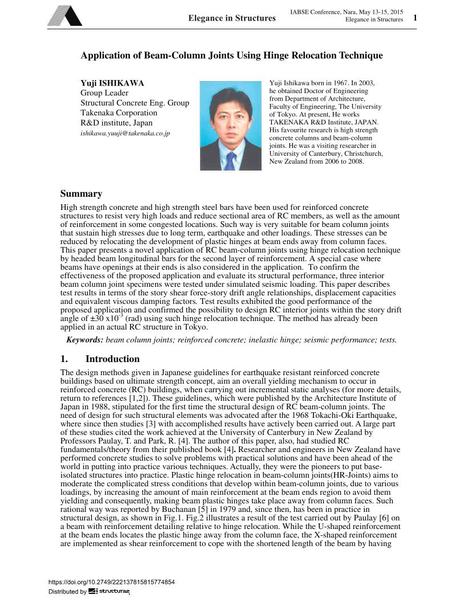Application of Beam-Column Joints Using Hinge Relocation Technique

|
|
|||||||||||
Bibliografische Angaben
| Autor(en): |
Yuji Ishikawa
|
||||
|---|---|---|---|---|---|
| Medium: | Tagungsbeitrag | ||||
| Sprache(n): | Englisch | ||||
| Tagung: | IABSE Conference: Elegance in structures, Nara, Japan, 13-15 May 2015 | ||||
| Veröffentlicht in: | IABSE Conference Nara 2015 | ||||
|
|||||
| Seite(n): | 250-251 | ||||
| Anzahl der Seiten (im PDF): | 8 | ||||
| Jahr: | 2015 | ||||
| DOI: | 10.2749/222137815815774854 | ||||
| Abstrakt: |
High strength concrete and high strength steel bars have been used for reinforced concrete structures to resist very high loads and reduce sectional area of RC members, as well as the amount of reinforcement in some congested locations. Such way is very suitable for beam column joints that sustain high stresses due to long term, earthquake and other loadings. These stresses can be reduced by relocating the development of plastic hinges at beam ends away from column faces. This paper presents a novel application of RC beam-column joints using hinge relocation technique by headed beam longitudinal bars for the second layer of reinforcement. A special case where beams have openings at their ends is also considered in the application. To confirm the effectiveness of the proposed application and evaluate its structural performance, three interior beam column joint specimens were tested under simulated seismic loading. This paper describes test results in terms of the story shear force-story drift angle relationships, displacement capacities and equivalent viscous damping factors. Test results exhibited the good performance of the proposed application and confirmed the possibility to design RC interior joints within the story drift angle of ±30 x10-3 (rad) using such hinge relocation technique. The method has already been applied in an actual RC structure in Tokyo. |
||||
| Stichwörter: |
Versuche Tests Stahlbeton
|
||||
